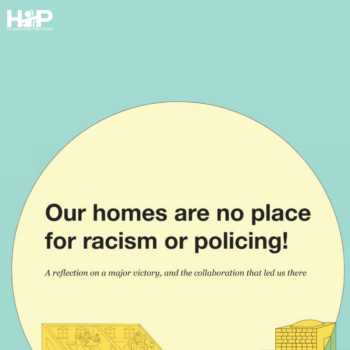| By Sara Satinsky |
Today, Human Impact Partners released a report that examines a critical perspective undervalued in current conversations about policing: the health perspective. Shocking cases of mistreatment, injury, and death grab headlines and go viral on social media; this report fills in the less often discussed mental, emotional, and behavioral impacts of policing for communities of color and police officers.
Developed in partnership with the Ohio Justice & Policy Center and Ohio Organizing Collaborative, and with the assistance of a 14-member Advisory Committee, Stress on the Streets (SOS): Race, Policing, Health, and Increasing Trust, not Trauma describes how policing practices affect the health of black communities and police. The report draws upon research evidence in health and criminology from across the US, as well as new information from a survey of 470 residents in select neighborhoods of Cincinnati and Akron, eight focus groups that included police and community, and conversations with key informants.
The report shows that for many black people, the perceived color of their skin means more uneasy interactions with police than white people, and stress and anxiety that in turn result in poorer physical and mental health. Among black respondents, nearly 59 percent said they have stress specifically because of police encounters compared to about 40 percent of white respondents. The report also shows that for police, heightened stress and anxiety put officers at greater risk of cardiovascular disease, substance abuse, depression, and suicide.
Survey findings include:
- About one in seven black respondents reported being stopped by police one or two times a day, and almost one in five reported being stopped one or two times a week. Only three percent of white respondents reported being stopped once or twice daily, and just another two percent said they were stopped once or twice weekly.
- Among white respondents, almost 70 percent said they trust the police in their community either “somewhat” or “a lot” compared to about 40 percent of black respondents.
- Nearly two-thirds of black respondents said they had feared police would injure or kill them, or had those fears for someone else in an incident they witnessed. The response from white respondents was almost the exact opposite – nearly two-thirds said they’d never had those fears.
The good news is the report finds that changes in policing models and practices can build trust between police and black communities, improving public health and public safety.
The report looked at four widely accepted models of policing, finding that the problem-solving approach in combination with community policing is most effective in reducing crime, building trust, and addressing inequities. The standard model is least effective for these outcomes. The report also finds that based on available information, Akron’s approach is similar to the standard model with some indication of community policing, while Cincinnati’s approach combines the community-oriented and problem-solving models.
The report assessed four specific practices getting a lot of attention these days – civilian review boards, body-worn cameras, department-wide performance measures, and training, supervision, and evaluation of officers. If fully implemented as described in the report, these practices can increase public trust, and some can reduce the use of force. If not properly implemented, these practices can actually lead to harms.
To improve public health and public safety – in Akron, Cincinnati, other cities in Ohio, and nationwide – the report makes five priority recommendations (the full report details specific actions for implementing recommendations and who can do them):
- Publicly recognize the historical contexts that have shaped current relationships between the public and police.
- Implement community-oriented and problem-oriented policing according to promising practices, with primary aims of improving public safety and building trust.
- Fully implement the four specific practices described in this report.
- Issue an annual State of Police report and identify, regularly collect, and publicly report department-level measures that include and go beyond crime statistics, and report statistics by race or ethnicity.
- Match police department resources – including staff skill sets – to the responsibilities necessary to serve all communities and create MOUs with community-based organizations to fill gaps beyond the skill sets of police.
Visit www.TrustNotTrauma.org for a full electronic version of the report, executive summary, and appendices. Be sure to follow #TrustNotTrauma to find out more about any additional activities related to these findings.
Advisory Committee members include the following (in alphabetical order; organizational names are included for identification purposes): Amy Bush Stevens of Health Policy Institute of Ohio, DaMareo Cooper of Ohio Organizing Collaborative, Erik Crew of Ohio Justice & Policy Center, Patrisse Cullors of Ella Baker Center for Human Rights, John Eck of University of Cincinnati, Victor Garcia of Cincinnati Children’s Hospital Medical Center and CoreChange, Raymond (Ray) E. Greene, Jr. of Altruistic Organization and My Brother’s Keeper, James Hayes of Ohio Student Association, Maris Herold of Cincinnati Police Department, Stephen JohnsonGrove of Ohio Justice & Policy Center, Camille A. Jones of Cincinnati Health Department, Iris Roley of Cincinnati Black United Front, Amaha Sellassie of Ohio Student Association and Sinclair Community College, and Susan Shah of Vera Institute of Justice.




